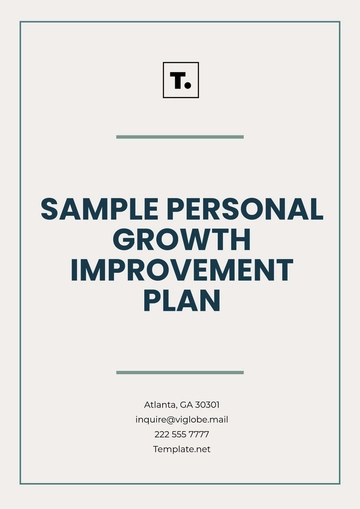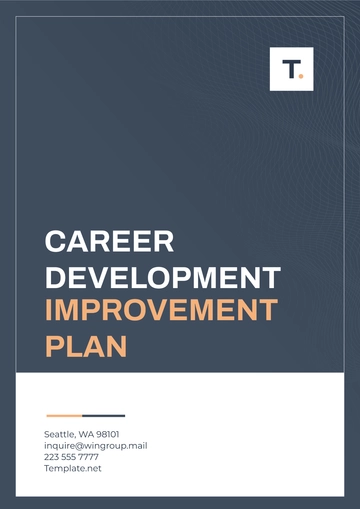Free Simple Financial Improvement Plan

Prepared by:
[YOUR NAME]
[YOUR COMPANY NAME]
1. Objective
To enhance financial stability by focusing on debt reduction, increased savings, better cash flow management, and a sustainable investment strategy. This plan will outline specific, actionable steps to be taken over the next 6–12 months to improve financial health.
2. Current Financial Overview
Income: $4,500 per month
Expenses: $3,500 per month
Debt: $10,000 in credit card debt
Savings: $2,000 in emergency savings
Investments: None currently
3. Key Areas for Improvement
Debt Reduction: Focus on eliminating high-interest credit card debt.
Savings Increase: Build an emergency fund to cover 3–6 months of expenses.
Cash Flow Management: Review and reduce unnecessary monthly expenses.
Investment Strategy: Start basic investment for future growth, focusing on low-risk options.
4. Action Steps
A. Debt Reduction
Step 1: Assess the interest rates on all current debts and prioritize repayment of the highest-interest debt (likely credit card debt).
Step 2: Allocate $500 each month toward debt repayment, starting with the highest-interest debt.
Step 3: Refinance or consolidate debt if possible to lower interest rates and reduce monthly payments.
B. Savings Increase
Step 1: Set a goal to build a 3-month emergency fund, targeting $10,500 ($3,500 x 3 months).
Step 2: Automatically transfer $300 per month to a high-yield savings account.
Step 3: Avoid unnecessary withdrawals from the savings account.
C. Cash Flow Management
Step 1: Review monthly expenses and identify areas for cuts, such as dining out, subscriptions, or entertainment.
Step 2: Create a budget to track income and expenses, ensuring that monthly expenses do not exceed $3,500.
Step 3: Set aside 10% of monthly income ($450) for discretionary spending or emergencies.
D. Investment Strategy
Step 1: Research low-risk investment options such as index funds or a retirement account (IRA).
Step 2: Allocate 10% of monthly income ($450) toward investments, starting with an IRA or employer-sponsored 401(k) if available.
Step 3: Review investments quarterly and adjust as necessary based on financial goals.
5. Timeline
Action Item | Target Completion Date | Monthly Budget Allocation | Status (Ongoing/ Completed) |
|---|---|---|---|
Pay off high-interest credit card debt | 6 months | $500/month | Ongoing |
Build emergency savings (3 months) | 12 months | $300/month | Ongoing |
Reduce unnecessary expenses | 1 month | N/A | Ongoing |
Begin basic investment strategy | 3 months | $450/month | Ongoing |
6. Monitoring and Adjustments
Review progress every month to ensure that debt repayment, savings, and investment goals are on track.
Adjust the monthly budget if any significant changes in income or expenses occur.
Reassess the debt repayment strategy if additional funds become available.
After reaching the emergency savings goal, redirect the monthly savings allocation to investments.
7. Final Goal
The ultimate goal of this Simple Financial Improvement Plan is to achieve a balanced financial position with no high-interest debt, a fully funded emergency savings account, improved cash flow management, and an initial investment strategy that promotes long-term financial growth.
- 100% Customizable, free editor
- Access 1 Million+ Templates, photo’s & graphics
- Download or share as a template
- Click and replace photos, graphics, text, backgrounds
- Resize, crop, AI write & more
- Access advanced editor
The Simple Financial Improvement Plan Template from Template.net is fully editable and customizable, designed to streamline your financial planning. Tailor the plan to meet your specific financial goals and needs. Editable in our AI Editor Tool, this template offers a flexible and personalized approach, helping you track progress and improve your financial well-being.
You may also like
- Finance Plan
- Construction Plan
- Sales Plan
- Development Plan
- Career Plan
- Budget Plan
- HR Plan
- Education Plan
- Transition Plan
- Work Plan
- Training Plan
- Communication Plan
- Operation Plan
- Health And Safety Plan
- Strategy Plan
- Professional Development Plan
- Advertising Plan
- Risk Management Plan
- Restaurant Plan
- School Plan
- Nursing Home Patient Care Plan
- Nursing Care Plan
- Plan Event
- Startup Plan
- Social Media Plan
- Staffing Plan
- Annual Plan
- Content Plan
- Payment Plan
- Implementation Plan
- Hotel Plan
- Workout Plan
- Accounting Plan
- Campaign Plan
- Essay Plan
- 30 60 90 Day Plan
- Research Plan
- Recruitment Plan
- 90 Day Plan
- Quarterly Plan
- Emergency Plan
- 5 Year Plan
- Gym Plan
- Personal Plan
- IT and Software Plan
- Treatment Plan
- Real Estate Plan
- Law Firm Plan
- Healthcare Plan
- Improvement Plan
- Media Plan
- 5 Year Business Plan
- Learning Plan
- Marketing Campaign Plan
- Travel Agency Plan
- Cleaning Services Plan
- Interior Design Plan
- Performance Plan
- PR Plan
- Birth Plan
- Life Plan
- SEO Plan
- Disaster Recovery Plan
- Continuity Plan
- Launch Plan
- Legal Plan
- Behavior Plan
- Performance Improvement Plan
- Salon Plan
- Security Plan
- Security Management Plan
- Employee Development Plan
- Quality Plan
- Service Improvement Plan
- Growth Plan
- Incident Response Plan
- Basketball Plan
- Emergency Action Plan
- Product Launch Plan
- Spa Plan
- Employee Training Plan
- Data Analysis Plan
- Employee Action Plan
- Territory Plan
- Audit Plan
- Classroom Plan
- Activity Plan
- Parenting Plan
- Care Plan
- Project Execution Plan
- Exercise Plan
- Internship Plan
- Software Development Plan
- Continuous Improvement Plan
- Leave Plan
- 90 Day Sales Plan
- Advertising Agency Plan
- Employee Transition Plan
- Smart Action Plan
- Workplace Safety Plan
- Behavior Change Plan
- Contingency Plan
- Continuity of Operations Plan
- Health Plan
- Quality Control Plan
- Self Plan
- Sports Development Plan
- Change Management Plan
- Ecommerce Plan
- Personal Financial Plan
- Process Improvement Plan
- 30-60-90 Day Sales Plan
- Crisis Management Plan
- Engagement Plan
- Execution Plan
- Pandemic Plan
- Quality Assurance Plan
- Service Continuity Plan
- Agile Project Plan
- Fundraising Plan
- Job Transition Plan
- Asset Maintenance Plan
- Maintenance Plan
- Software Test Plan
- Staff Training and Development Plan
- 3 Year Plan
- Brand Activation Plan
- Release Plan
- Resource Plan
- Risk Mitigation Plan
- Teacher Plan
- 30 60 90 Day Plan for New Manager
- Food Safety Plan
- Food Truck Plan
- Hiring Plan
- Quality Management Plan
- Wellness Plan
- Behavior Intervention Plan
- Bonus Plan
- Investment Plan
- Maternity Leave Plan
- Pandemic Response Plan
- Succession Planning
- Coaching Plan
- Configuration Management Plan
- Remote Work Plan
- Self Care Plan
- Teaching Plan
- 100-Day Plan
- HACCP Plan
- Student Plan
- Sustainability Plan
- 30 60 90 Day Plan for Interview
- Access Plan
- Site Specific Safety Plan




























